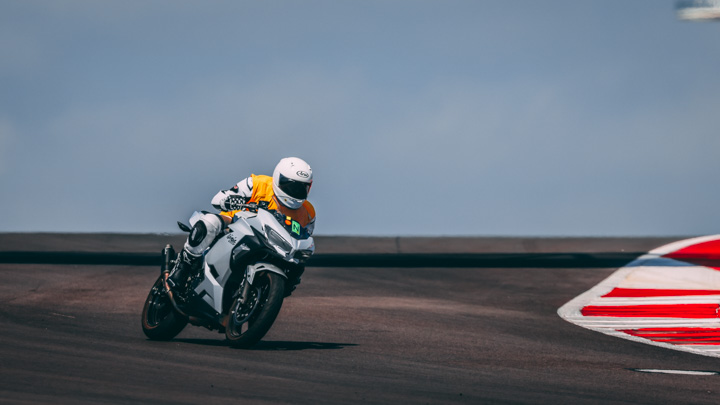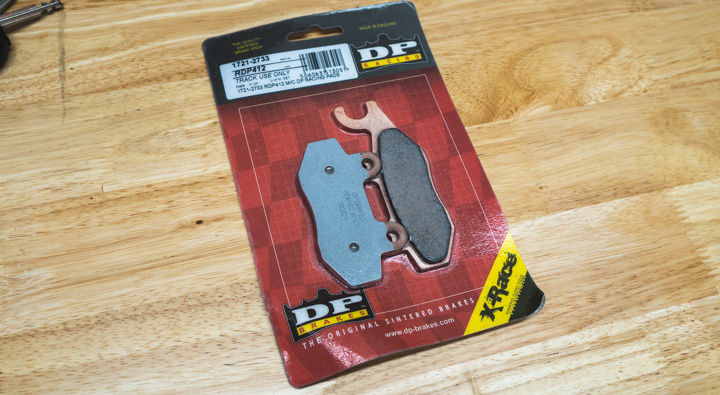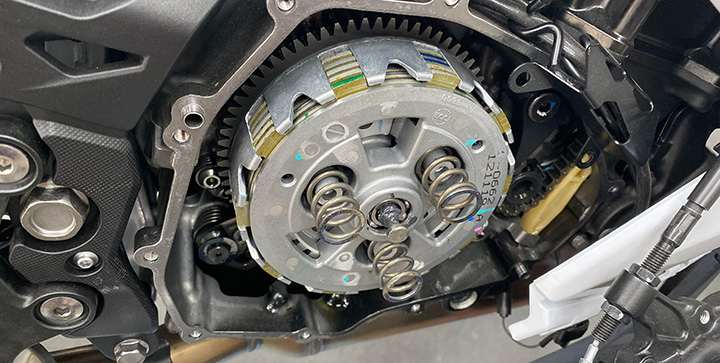Ninja 400

The Ninja 400 is a light and quick little 399cc twin-cylinder sportbike. With a low seat height and decent ergonomics, this bike is great for the street and commuting with an aggressive look and feel. This bike is great for beginners as it is approachable with manageable power at your wrist.
But can this bike make a name for itself on the track? Of course it can! In fact many moto america junior cup racers use them and there is a plethora of parts and upgrades for this little bike for an awesome day at the track or races. Let's take a look at some this Ninja's shortcomings and we can make this bike a little more track ready.

Brakes
A good track bike needs good brakes, and the OEM brakes that come on the Ninja 400 are decent for the street, but are not great for the track. One of the easiest things to do to improve braking performance is to replace the brake pads. The DP RDP Sintered Racing Pads are a good option to start with. They feature a High friction race compound sintered metal allowing riders to brake later and trail brake with control.

Another good idea to improve braking performance is to upgrade the rubber brake lines to stainless steel lines. This improves braking feel and response. Normal rubber brake lines can expand under heat and pressure which can cause a mushy brake feel, while the stainless steel lines withstand the heat, pressure and expansion much better. The Spiegler Front & Rear Brake Line Kit is a popular choice because of the performance and the color options.

Shorter Throttle Throw
One thing that is loathed by many Ninja 400 track riders is how long the throttle throw is. You have to practically break your wrist, past a 90° angle, to go WOT. This makes it incredibly uncomfortable to control your speed in all gears and rev ranges.
Luckily to fix this, we can replace the throttle tube with one from a Yamaha R6 (2006-2020). This Motion Pro TZF-R6 Throttle Sleeve works really well for this with just a few modifications to the throttle housing to make it fit.

Now that the diameter of the throttle sleeve is larger than the OEM one, it will be harder to twist the throttle. We can alleviate this by replacing our throttle return spring with a Norton Racing Soft Pull Throttle Return Spring to make it easier to twist the throttle without having extra strain on our wrist.

Clutch Springs
If you are in tune with your clutch and engine, and your chakra is aligned with your bike, then you might notice that the Ninja 400's clutch will slip when you don't want it to. It is true that the Ninja 400 is equipped with a slipper clutch, but the slipping is due to the commuter/casual focused clutch springs. By upgrading to the Spears Racing Clutch Spring Kit, you can mitigate this slipping and take control of your launches and starts. (This spring kit is designed to work with the OEM clutch). This change however will most likely shorten the life of your clutch if you don't have great clutch control to begin with.

Levers
An easy ergonomic upgrade is to swap out the brake and clutch levers. ASV has a great high quality selection for all makes and models, but there are plenty of manufactures to choose from. For this Ninja 400 let's go with the ASV F3 Series Lever because of its micro-indexing dial reach adjuster which lets us fine to how far the lever is out from the handlebar to perfectly suit our hand size. Plus you can choose from a few different color options.
And don't forget to follow Dave Moss's advice, and adjust the angle of the levers to point more down to match the angle of your arms for a more comfortable grip and ergonomic operation. Just loosen the bolts on the lever and adjust the angle to match you and your riding style.
Bike Protection
For a track bike, you will need some sort of bike protection to prevent your bike from bleeding oil all over the track. You will definitely want to pick up some engine and clutch covers to protect your valuable engine in the event of a low-side. For the Ninja 400, we went with the GB Racing Clutch Cover and the GB Racing Alternator Cover that bolt on over the top of the clutch and alternator respectively.
If you search around on the internet you will find very mixed opinions on the topic of frame sliders. Some say it saved their bike from catastrophe, others say that the frame sliders are the reason their bike had a catastrophe. During a low-side it is very possible that the frame slider will catch on something and will cause your bike to flip and tumble, thus causing the damage to be worse than if the bike had no frame sliders at all.
We are going with no frame sliders for this bike, but we are using some swing arm spool sliders for the sake of protecting the swing arm a bit, and making it easier to use a stand to lift the rear of the bike up.
Have Fun

